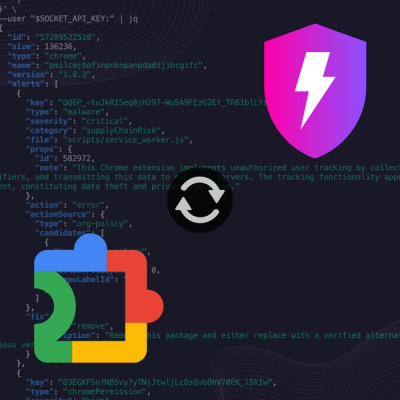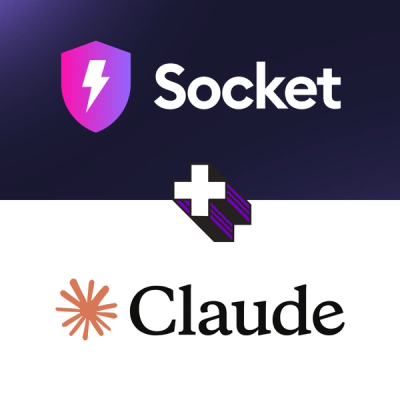
Product
Socket Now Protects the Chrome Extension Ecosystem
Socket is launching experimental protection for Chrome extensions, scanning for malware and risky permissions to prevent silent supply chain attacks.
persephone-client-py
Advanced tools
You can install persephone-client-pi from pip::
$ pip install persephone-client-py
There are two main classes - PersephoneClient and PersephoneBuildHelper. The former can be
used to access the full-range of the API, while the latter is more useful during a CI run in order
to create a build, upload screenshots and finish the build.
PersephoneBuildHelper to submit screenshots during a build
=======================================================================The example here uses the standard Jenkins environment variables. You can use anything else instead::
# For example in your setUpClass method or wrapper script
persephone = PersephoneBuildHelper(
'http://persephone.yourdomain.com',
'username',
'password',
'1',
os.getenv('ghprbActualCommit'),
os.getenv('ghprbSourceBranch'),
os.getenv('BUILD_NUMBER'),
os.getenv('BUILD_URL'),
os.getenv('ghprbPullId'),
)
persephone.create_build()
# In your testcase, assuming self.driver is a Selenium driver instance
persephone.upload_screenshot('Main Page.png', self.driver.screenshot_as_png())
# After the build is finished - tearDownClass or end of wrapper script
persephone.finish_build()
If you create the build and then want to use a separate instance of PersephoneBuildHelper to
upload the screenshots (for example the build is managed by a wrapper script), you can access the
build ID using persephone.build_id right after calling create_build and pass that to the
testing module. Inside, you can create a minimal PersephoneBuildHelper using only the endpoint,
username, password and build_id and use that to upload the screenshots.
If you're using Jenkins or CircleCI to build your project, then you can skip some of the work
described above. persephone-client-py comes with helper classes that can take most of the
information from the environment variables those system provide. You still have to provide the
endpoint, username, password and project ID. That can be done either via environment variables
(PERSEPHONE_ENDPOINT, PERSEPHONE_USERNAME, PERSEPHONE_PASSWORD,
PERSEPHONE_PROJECT_ID) or by passing them via kwargs to the respective constructor. If those
environment variables are present, you can just construct the objects and start using the API::
persephone = JenkinsBuildHelper()
# or
persephone = CircleCIBuildHelper()
# and then
persephone.create_build()
persephone.upload_screenshot(...)
The Jenkins helper support standard builds as well as those triggered by the GitHub Pull Request Builder plugin. CircleCI has native support for master/branch/PR builds.
After you install persephone-client-py, you can use the persephone_cli command-line interface to
manage builds and upload screenshots. The configuration parameters (endpoint, username, etc.) can be
passed via environment variables or command line options. You can list the options using
persephone_cli --help. The environment variables are available with the PERSEPHONE_ prefix.
For example, if the command-line option is --commit-hash the respective environment variable is
PERSEPHONE_COMMIT_HASH. The environment variables, if present, can still be overridden using the
command line options.
Creating a build::
$ persephone-cli --endpoint "http://persephone.yourdomain.com/" --username admin \
--password admin create_build
5
The above command outputs the new build ID. To upload a screenshot::
$ persephone-cli --endpoint "http://persephone.yourdomain.com/" --username admin \
--password admin upload_screenshot --build-id 5 --image-path myimage.png \
--image-name "Main Page.png"
FAQs
A Python client for the Persephone REST API
We found that persephone-client-py demonstrated a healthy version release cadence and project activity because the last version was released less than a year ago. It has 1 open source maintainer collaborating on the project.
Did you know?

Socket for GitHub automatically highlights issues in each pull request and monitors the health of all your open source dependencies. Discover the contents of your packages and block harmful activity before you install or update your dependencies.

Product
Socket is launching experimental protection for Chrome extensions, scanning for malware and risky permissions to prevent silent supply chain attacks.

Product
Add secure dependency scanning to Claude Desktop with Socket MCP, a one-click extension that keeps your coding conversations safe from malicious packages.

Product
Socket now supports Scala and Kotlin, bringing AI-powered threat detection to JVM projects with easy manifest generation and fast, accurate scans.